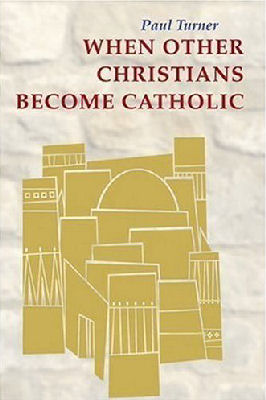
|
Posted February 12, 2007
Book: When Other Christians Become Catholic Author: Paul Turner Liturgical Press. Collegeville, MN. 2007. Pp. 172 An Excerpt from the Jacket:
In When Other Christians Become Catholic, Paul Turner seeks to clarify and confirm the status of baptized persons. He explores the rites of reception in the early church and the Second Vatican Council’s call for ecumenical dialogue. In addition, he looks to the reception rites of other Christian communities to gain added perspective. Turner’s historical and ecumenically sensitive analysis will help members of catechumenate teams think more carefully about the bapitismal unity of all Christians. Drawing on that foundation of unity, they will learn steps to avoid and steps to take so that communion becomes a reality. An Excerpt from the Book: Mary Birmingham outlines the six tasks of catechesis appearing in paragraphs 85 and 86 of the General Directory for Catechesis: Initiation catechesis is a proclamation . . .of Jesus Christ (knowledge of the faith). It is an invitation to pray as Jesus prayed (teaching to pray). . . [It] is to promote an understanding of the liturgy and sacraments (liturgical education). . . It forms disciples to live life in Christian community. . . .(education for communal life). Catechesis forms people in a life of prayer, in praise of God and for apostolic service, mission and witness (missionary initiation). These directives help determine what catechesis is sufficient, while they give pastoral leaders the flexibility to discern readiness individually with the persons in question. James Dunning proposed a fourfold analysis of the candidates’s spiritual journey, based on the elements that make up catechetical formation for the unbaptized in the period of the catechumenate. During that time, “A suitable catechesis is provided.” Catechumens “become familiar with the Christian way of life.” The church helps them with “suitable liturgical rites.” And they “learn how to work actively with others to spread the Gospel.” Dunning says every candidate stands somewhere on each of four different continuum based on these categories of formation: word, worship, community, and service. On the word continuum, people stand somewhere between a “literalist understanding” of the bible and an “understanding of its meaning.” For example, someone may move from believing that God created the world in exactly six days to an understanding that the first chapters of Genesis teach more broadly the meaning tha God is the Creator. In terms of worship, people stand somewhere in a continuum between “privatistic prayer” and “public worship.” . . . On the community continuum, people stand somewhere between “rugged individualism” and “communal interdependence.” . . .Closely related is the service continuum, where people stand between “concern for one’s own salvation: to “witnessing for the salvation of the world.” Table of Contents: Part I: Not the Beginning 1. Baptized Christians Part II: The Birth of a Rite 2. The reception of heretics 3. The ecumenical movement 4. The development of the new rite 5. The English translation in the United States Part III: The Journey to Fullness 6. Siblings 7. Theological explorations Part IV: In Search of Communion 8. Discerning readiness 9. Ritual issues 10. The clouded vision in the United States |
|
